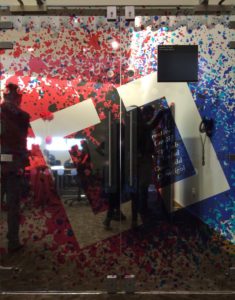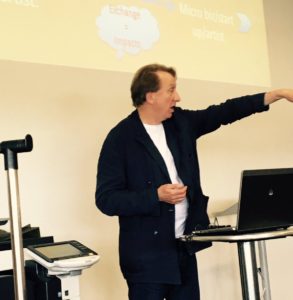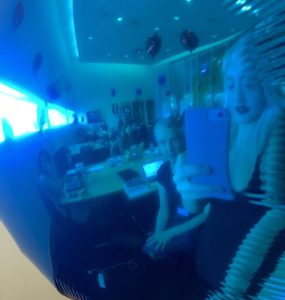All images taken from social media linked to the project
In the same week that it was announced that Britain was leaving the EU, free-thinkers in Cardiff were exploring new and innovative ways for arts professionals to work together as part of the Creative Cardiff pop-up hub.
From the 20th-24th June selected creatives occupied a temporary pop-up workspace in the Wales Millennium Centre as part of an initiative organised by Creative Cardiff. Sara Pepper, director of Creative Economies at Cardiff University, was a key organiser of the event having researched existing approaches to creative hubs both within, and outside of Wales. Pepper champions ‘hub’ models as potential centres for innovation within the Cardiff creative economy. Sara Pepper has authored a blog post in which she outlines her research which you can access via the link below:
http://blogs.cardiff.ac.uk/creative-economy/2016/06/16/a-creative-hub-for-cardiff/
Creative Cardiff is an online network of practicing creatives in the Cardiff area initiated by a team at Cardiff University. The network went live in October 2015 and already currently has a membership of over 550 practitioners.
This form of online network has already proven useful to both my peers and myself, practicing within universities as well as on a freelance basis. Organisations such as EMVAN (The East Midlands Visual Arts Network) provide valuable access to creative opportunities and share relevant events information, thus implementing a meeting of like-minded practicing creatives and audiences alike.
What Creative Cardiff achieved in this recent venture is to demonstrate that the hub environment prompted an acceleration of the outputs of its occupants whilst retaining its supportive values. There are early indications that hubs may prove to be beneficial to the development of creative networks and productivity within the city. That these values could be propagated successfully within the physical space of a hub supports the demand for more dedicated collision spaces for creatives, which could support existing online networks.
“Our network aims to bring together people from across the full breadth of the city’s creative economy – from dancers and marketing professionals to architects and app developers. By collaborating and sharing ideas we want to encourage more innovation and creativity in our city” – Creative Cardiff.
Reflecting on my own experience of working in the hub, I found the pop-up nature of the arrangement provoked thought and reflection on the nature of the co-operative working arrangement rather than focusing on the development of individual creatives. This differs from the way in which arts students or employees within other creative industries are usually encouraged to practice, and on the surface seems to contradict productivity. Although the arrangement of the short-term hub might have been initially disruptive, established examples have indicated that co-operative working increases productivity – hence Google’s eagerness to provide exciting, open workspaces for their employees to work collaboratively.
I found the group was particularly concerned with how professionals from various creative fields might gather to achieve the aforementioned aims of Creative Cardiff, whilst still continuing to realise autonomous objectives within their own creative practices. Countless discussions were had on the topic, and throughout the week questions were raised regarding the benefits, physical design, core values, social and creative impact of working in this way to name but a few. Issues such as these are often interrogated on occasions where creative practice mingles with academic insight.
A particularly successful feature of the pop-up hub was the daily ‘Provocation Sessions’ provided in the mornings within the hub space. During these sessions, the hub members were invited to hear professional reflections on the nature of creative spaces and productivity and discussion on these topics was encouraged. We heard from a range of speakers including Prof. Wayne Forster of the Welsh School of Architecture, Clare Reddington and Jo Landsdowne of WATERSHED (Bristol) and Prof. Jonathan Dovey, UWE Professor of Screen Media and director of REACT. Such sessions provided an opportunity for focused learning and interaction amongst the hub members that I believed complimented more casual encounters experienced in the joint space.
I found Prof. Jonathan Dovey’s insights regarding the hub as a creative eco-system especially informative and motivational. His experience has demonstrated that hubs can provide instances of exchange, impacts and continued mutual support amongst their occupants. Dovey placed particular emphasis on the benefits of shared values within creative hubs, such as generosity, openness, trust and excitement.
It is the presence of these shared values, possessed by the members of the pop-up, which contributed towards the success of the Creative Cardiff hub, and defined the unique and progressive environment that I experienced as a member.
With the project only spanning over a short week, the conditions of the hub could not be established in the way in which an organically cultivated hub space might. However, many would agree that the potential for development and continuation of the project was evident. Through research carried out by Cardiff University, we can be positive the project has contributed to the development of creative hubs in Cardiff in the future. As well as this, I hope there is recognised potential for such hubs to become part of an interconnected network of creatives spanning Wales, the UK, and even Europe and globally.
Perhaps the potential of a hub network is way in which creatives can demonstrate that, despite established individualist tendencies, we are in fact better together.
To view Amelia’s Creative Cardiff profile, please follow the link below:
http://www.creativecardiff.org.uk/users/amelia-seren-roberts
Twitter: @amelia_seren






